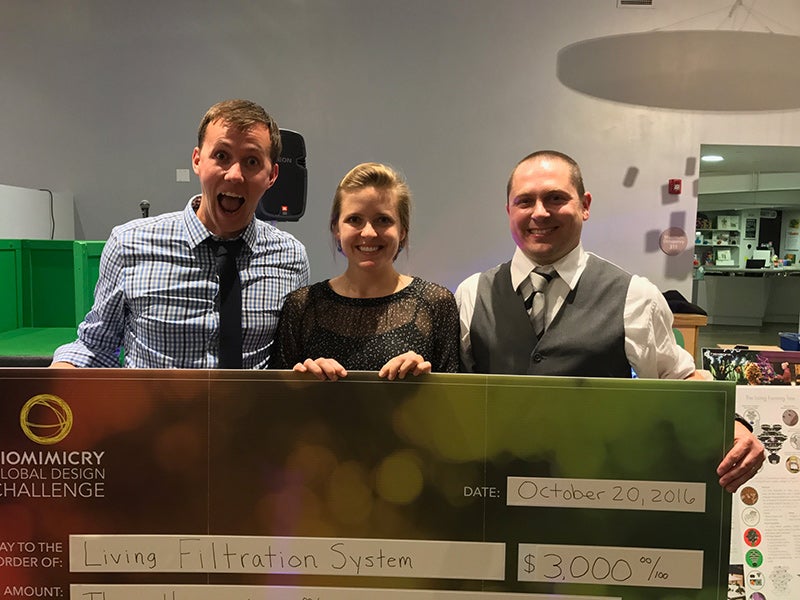A team of UO landscape architecture students won the People’s Choice award in the 2016 Biomimicry Global Design Challenge, along with a separate $10,000 cash prize, for their project “Living Filtration System.” The People’s Choice award included $3,000 plus software valued at another $3,000.
The team—Wade Hanson, Casey Howard, Matt Jorgensen, and Alison Lewis—was one of seven international finalists in the accelerator phase of the Biomimicry Global Design Challenge, an international design competition and accelerator program that crowdsources nature-inspired solutions to sustainability challenges such as climate change, food system issues, water management, and alternative energy.
The award tally makes a total of five cash prizes totaling $35,500 plus software that the team has won in competitions against professional teams.

Above: UO landscape architecture students (from left) Wade Hanson, Alison Lewis, and Matt Jorgensen celebrate their final prize from the Biomimicry Global Design Challenge.
More important, perhaps, than the money, the UO team was matched with business accelerator mentors who’ve coached them the past year and will continue to do so as the team moves their project forward.
The “Living Filtration” prototype is designed to trap excess fertilizer in agricultural fields where it can be gradually absorbed by plants rather than leaving fields as polluted runoff.
“We plan to keep our idea alive by forming partnerships with existing companies or agricultural departments within universities to round out our team and gain access to labs and field testing areas,” team spokeswoman Casey Howard said.
“The competition taught us to become self-directed, push our boundaries, and overall allowed us to feel like we're making a difference in the world, even if it is one small step at a time in the right direction.”
The team began their project in a spring 2015 class taught by UO Instructors Anne Godfrey and Emma Froh. In fall 2015, the team won the $10,000 first-place prize in the Biomimicry Challenge and advancement to the final round. The grand prize winner, a team from Chile, was announced in late October 2016.
“We are so incredibly honored by all of the interest and support we've received, and there's no doubt in my mind that none of this would have been possible without the incredibly talented professor Anne Godfrey,” Howard said. “She has been a huge inspiration from the beginning of my time at UO and continues to be a valued mentor and friend.”
Although the UO team did not win the $100,000 grand prize in the Biomimicry Challenge, the Ray C. Anderson Foundation awarded four runner-up teams $10,000 cash each, individual sponsors awarded the UO team $3,000 cash for winning the People’s Choice honor, and Autodesk gave the team software access valued at $3,000.
The new round of the Biomimicry Global Design Challenge just launched, presenting another opportunity for teams to compete for the annual “Ray of Hope” Prize.
